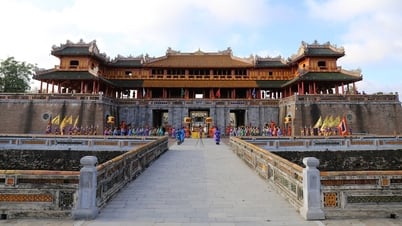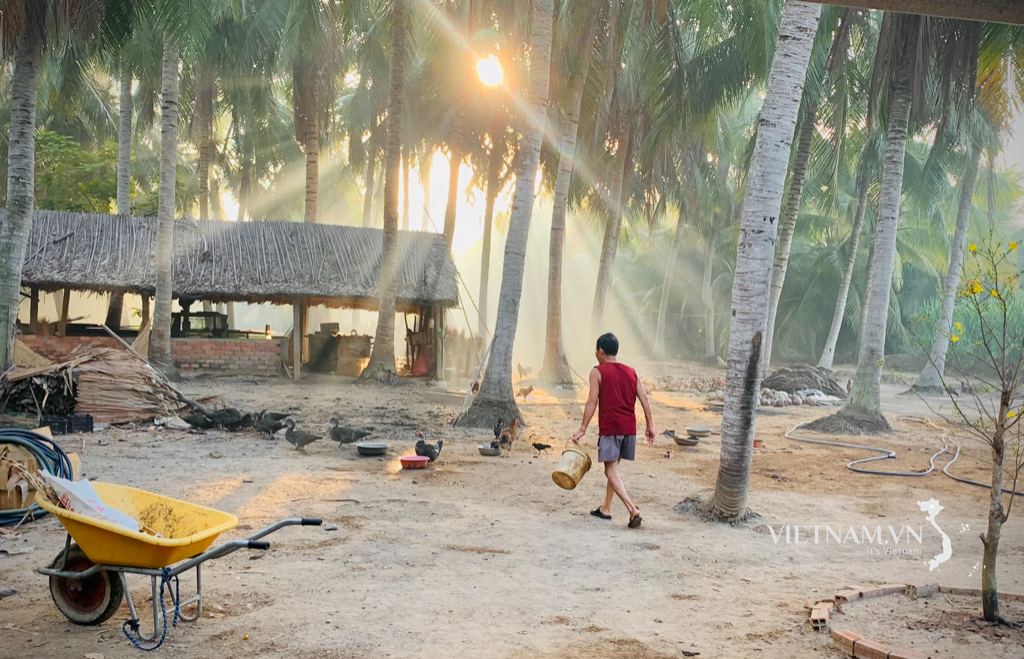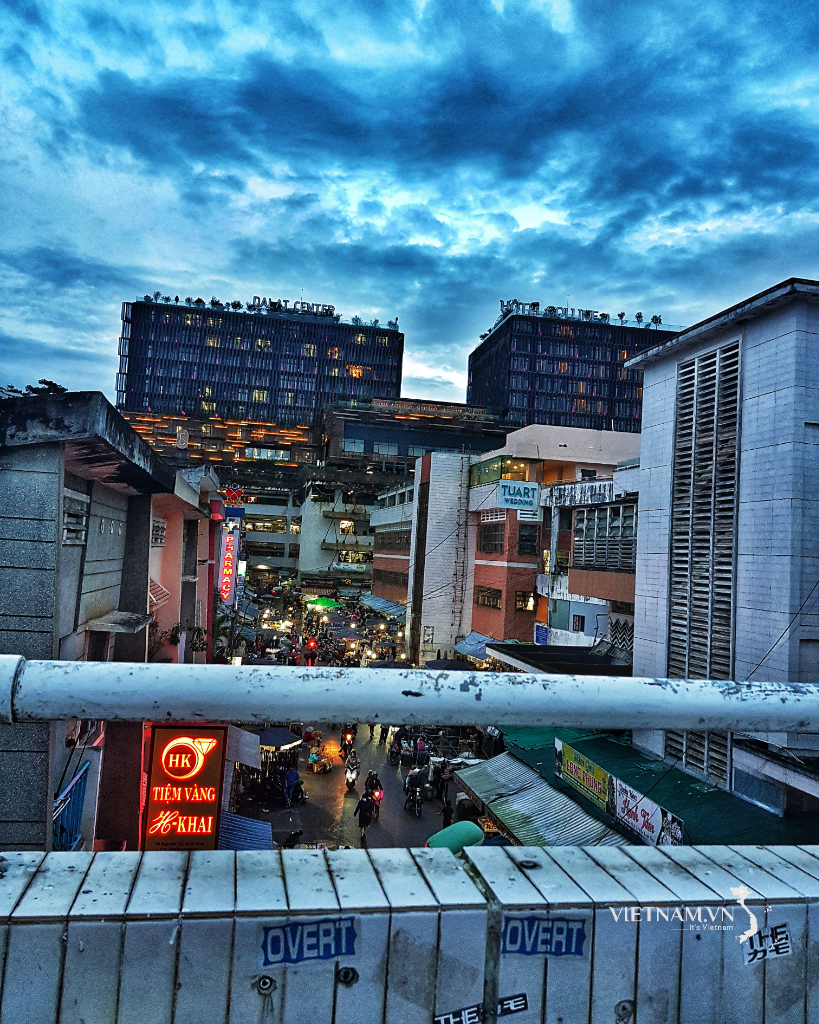Walking amidst the vast green expanse of production forests in the districts of Nhu Thanh, Nhu Xuan, Thuong Xuan, Lang Chanh, Thach Thanh..., we heard more and more stories of aspirations to get rich from the forest. On barren, rocky land, thanks to the hard work and intelligence of people, the green of life and peace in the vast forest is spreading further...
 A model of large-timber plantation in Xuan Thai commune (Nhu Thanh district).
A model of large-timber plantation in Xuan Thai commune (Nhu Thanh district).
Implementing reforms in forestry towards social forestry development, the focus has shifted from primarily exploiting forests to using forests as a catalyst for economic development, helping ethnic minority communities alleviate poverty and prosper from the forest. Special-use forests are strictly protected and invested in, remaining rich in forest resources with many rare and valuable forest products. Protective forests are increasingly better protected and developed. Planted forests are expanding in scale and structure, gradually shifting towards the use of high-yield tissue-cultured varieties, and planting large timber trees for domestic consumption and export, thus forming timber raw material areas.
Thanh Hoa province aims to plant, develop, and maintain 56,000 hectares of forest meeting the standards for large timber forests as stipulated by the Ministry of Agriculture and Rural Development during the 2021-2025 period. To achieve this goal, the province has implemented numerous solutions to improve the quality and efficiency of large timber forests and establish a sustainable forestry product chain.
Following the tree-lined paths, we visited the forest farm of Mr. Le Duy Hai's family in Khe Cat village, Thanh Tan commune (Nhu Thanh district), an effective and innovative model of developing commercial timber plantations, showcasing the efforts and dedication of the people involved. Welcoming us with enthusiasm, Mr. Hai happily shared: "My family received a land lease for forestry purposes, covering 12.6 hectares, in 2018. To date, we have planted and cared for 12.6 hectares of large timber forest, including 2.6 hectares of hybrid acacia, using our own family investment..."
Looking out over the forest, Nguyen Van Dung, Director of the Nhu Thanh Protective Forest Management Board, and many officials and workers shared: The Nhu Thanh Protective Forest Management Board has been proactively implementing solutions to form concentrated, specialized, and intensive production forest areas, linking forest planting with processing and the market for forest products, improving the efficiency of forest production and utilization, attracting and creating more jobs, increasing income for forest workers, and protecting the ecological environment. The focus is on planting forests with high-quality forestry trees and tissue-cultured trees, increasing income for forest owners.
From 2015 to March 2024,
The Nhu Thanh Forest Management Board has provided technical guidance, supplied seedlings, and organized households contracted to plant new forests and replant harvested forests according to regulations, covering more than 3,950 hectares of production forest. A new development is that in the three years from 2021 to 2023, the board planted 168 hectares of tissue-cultured acacia trees and 40 hectares of cinnamon trees...
In recent years, the entire province has implemented dozens of intensive large-timber forest planting models in districts such as Nhu Thanh, Nhu Xuan, Lang Chanh, and Thuong Xuan, to promote and guide people to replicate these models on a wider scale. Monitoring and evaluation by specialized agencies show that large-timber plantations achieve the highest growth rate during the 8-12 year old stage. Through the model of converting acacia forests for large-timber production, the average total forest volume reaches approximately 250 m³/ha, with an average revenue of about 350 million VND/ha/cycle. Meanwhile, small timber for paper production (wood chips) fetches over 1.1 million VND/ton, averaging 90-130 million VND/ha/2 cycles for small timber. On the same forest area, converting small-timber forests into large-timber forests takes approximately 5-7 years longer than small-timber forests, but the economic value is 2.5-3 times higher than continuously carrying out two small-timber production cycles. Large-timber production reduces the number of harvesting and replanting cycles, contributing to reducing erosion, protecting the environment, and combating climate change.
By March 2024, Thanh Hoa province had a total of 56,000 hectares of commercial timber plantations. The main tree species planted are Australian acacia, Dipterocarpus, Melia azedarach, Lagerstroemia indica, and Dalbergia tonkinensis, which are being well cared for, protected, and developed. The entire province has 20,149.18 hectares of planted forests (bamboo and rattan) in Thach Thanh, Quan Hoa, and Quan Son districts that have been certified by the Global Sustainable Forest Management Organization (GFA) for sustainable forest management (FSC), contributing to increasing the added value of the forestry sector. Many households in mountainous areas have invested in building large timber plantation and forest protection models combined with short-term crops, generating high incomes. When planted forests reach the harvesting stage according to regulations, the forest owners will replenish the area with new large timber forests.
However, developing large-scale timber forests in Thanh Hoa is facing many difficulties. The mountainous area's degraded transportation infrastructure is hindering the attraction of investment from businesses. The long business cycle and large investment capital mean that only households with sufficient capital and large land areas can afford to develop large-scale timber forests. Natural disasters such as storms, floods, and prolonged droughts can cause damage to forest owners.
To achieve the goal of developing a stable large-scale timber business area of approximately 56,000 hectares by 2025, meeting the demand for large timber for deep processing and export, the Provincial People's Committee has assigned tasks to relevant departments, agencies, and the People's Committees of districts to implement comprehensive solutions from planning to organizing planting, caring for, harvesting, and processing forest products; and to promote and mobilize the people to contribute all social resources to the development of large-scale timber forest businesses. To support organizations and individuals planting production forests using tissue-cultured seedlings, on December 10, 2021, the Provincial People's Council issued Resolution No. 185/2021/NQ-HĐND on promulgating policies for the development of agriculture, rural areas, and farmers in Thanh Hoa province, giai đoạn 2022-2025. Accordingly, the support level is 1,300 VND/seedling, with a maximum of 2 million VND/ha. Eligibility requirements: Organizations, families, and individuals are allocated land, leased land, or contracted land for production forest planting by the State. The area for planting production forest using tissue-cultured seedlings must be at least 1 hectare for households and individuals, and at least 20 hectares for organizations.
In an interview with us, Deputy Head of the Thanh Hoa Forest Protection Department, Thieu Van Luc, stated: Implementing policies to support concentrated forest planting using tissue-cultured trees, the province has planted over 5,000 hectares of concentrated forest using tissue-cultured trees over the past three years (2021-2023). The entire area of forest planted with tissue-cultured trees is being cared for, protected, and is growing and developing well. The Forest Protection Department has directed state-owned forest owners and forest protection units to proactively plan seed sources and establish quality forestry seedling nurseries for reforestation; and provide technical guidance on new forest planting. They are also promoting and encouraging people and forest owners to implement sustainable mixed forest management models, combining large timber trees with short-cycle species to ensure immediate income for forest owners before the large timber forests reach their harvesting stage. The focus is on directing localities and forest owners to strengthen the management and use of high-quality forestry seedlings in planting large timber forests (tissue-cultured trees) and applying intensive forest planting methods to improve the productivity and quality of planted forests. The directive emphasizes the successful completion of technical designs for forestry projects; preparing the site for planting 10,000 hectares of concentrated forest in 2024, including 1,500 hectares planted with tissue-cultured trees. The Sub-Department will continue to advise the Department of Agriculture and Rural Development to urge the People's Committees of districts to effectively implement policies supporting the planting of production forests using tissue-cultured trees. It will also attract businesses to invest in forest planting projects along the value chain from production to processing, building raw material areas through supporting forest planters in purchasing their products.
With the determined leadership of the Provincial People's Committee and the involvement of various departments and localities, along with the willpower, determination, boldness, and aspiration for wealth of the people in this beloved green forest region, the efficiency of forest planting is being improved, creating breakthroughs in the development of forestry economics and contributing to the protection of the "green lungs" of the province.
Thuy Duong
Source
















































































































Comment (0)